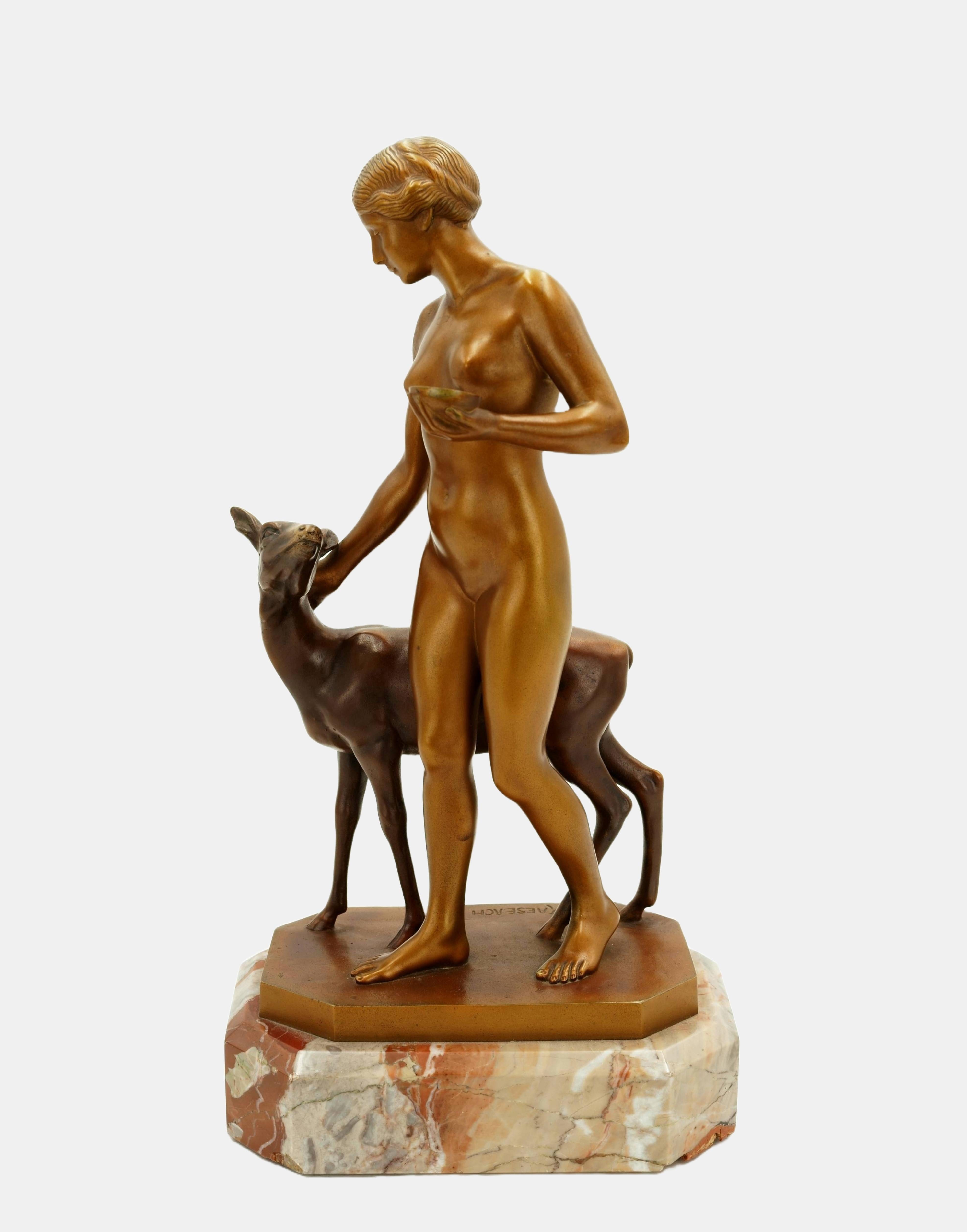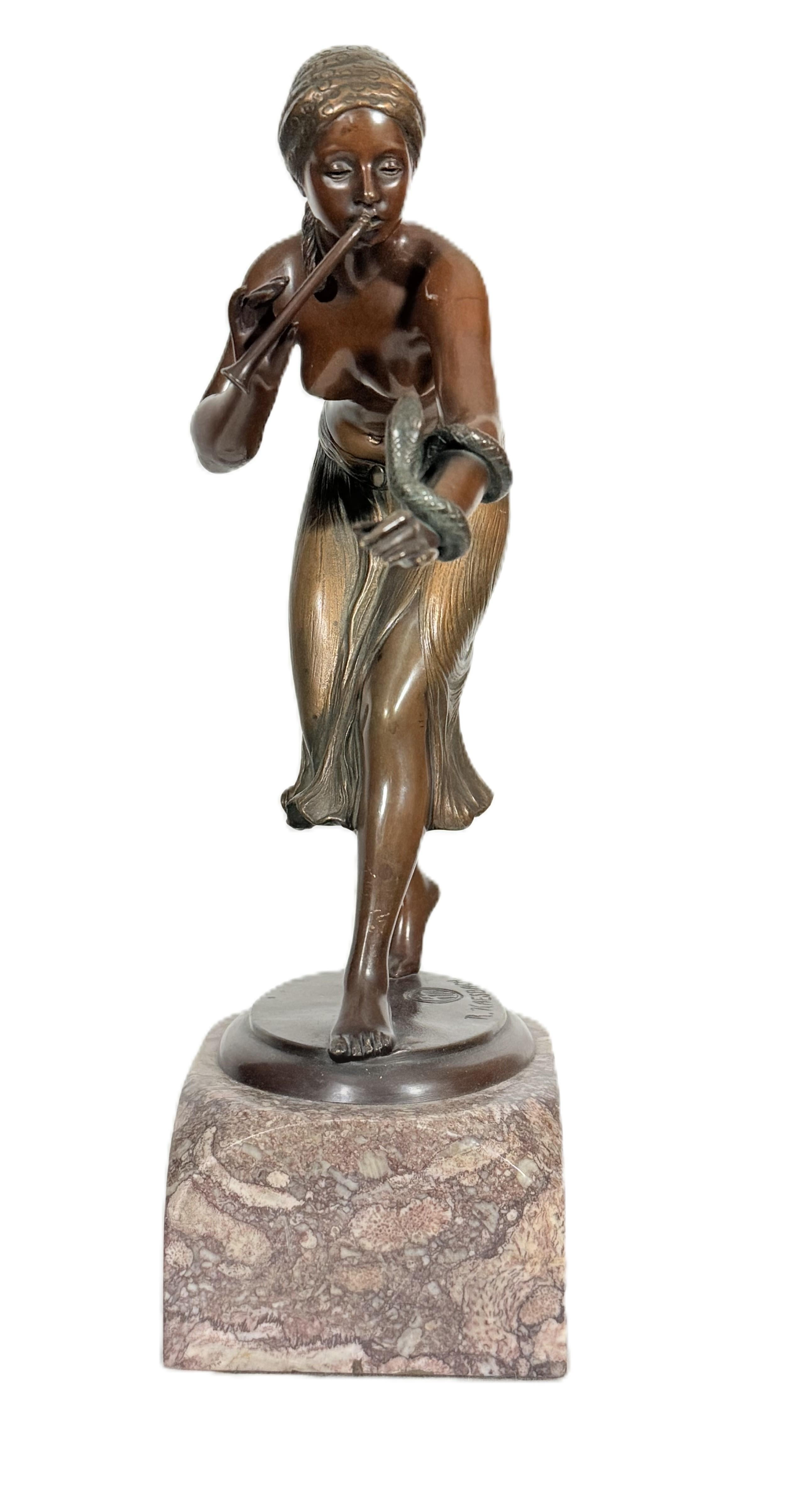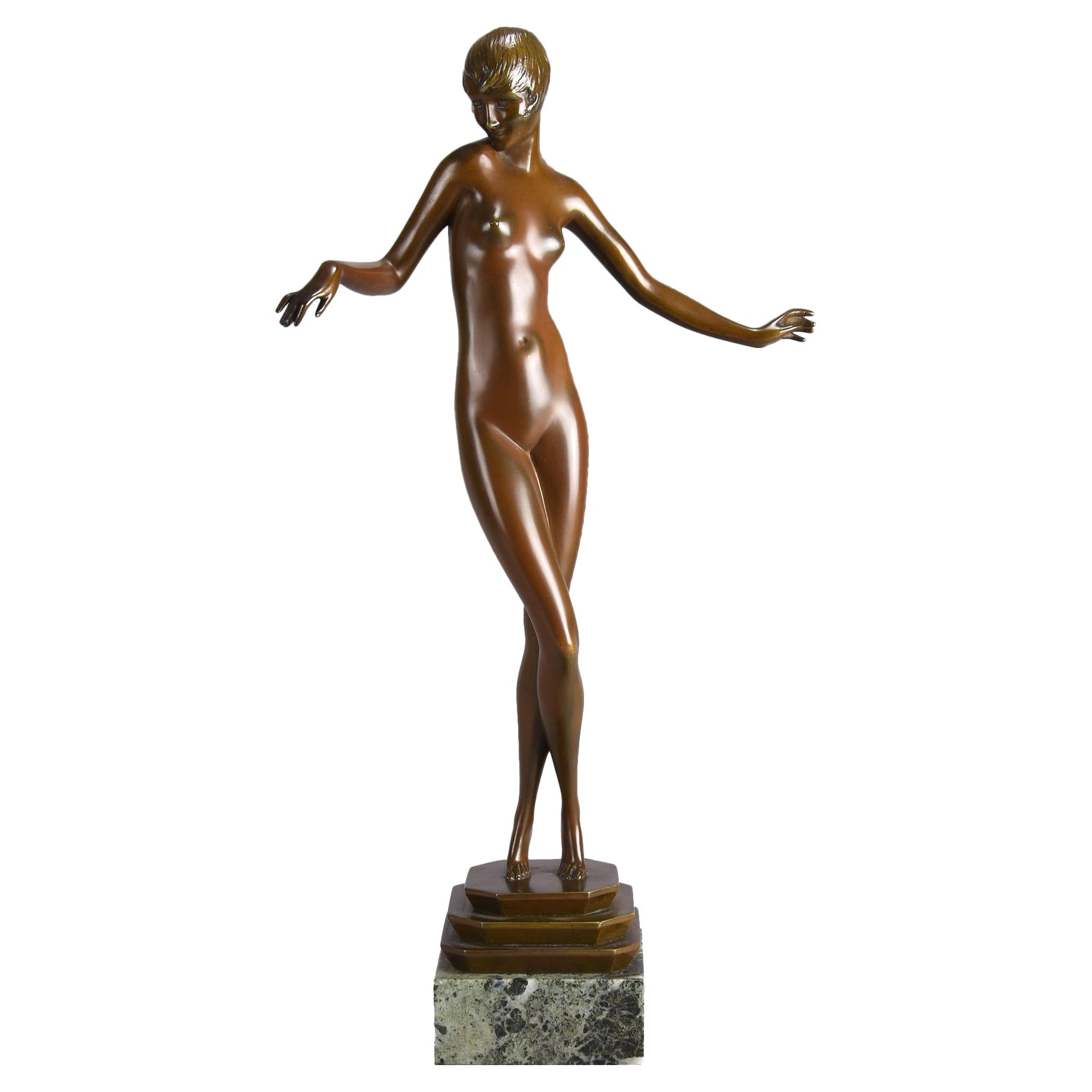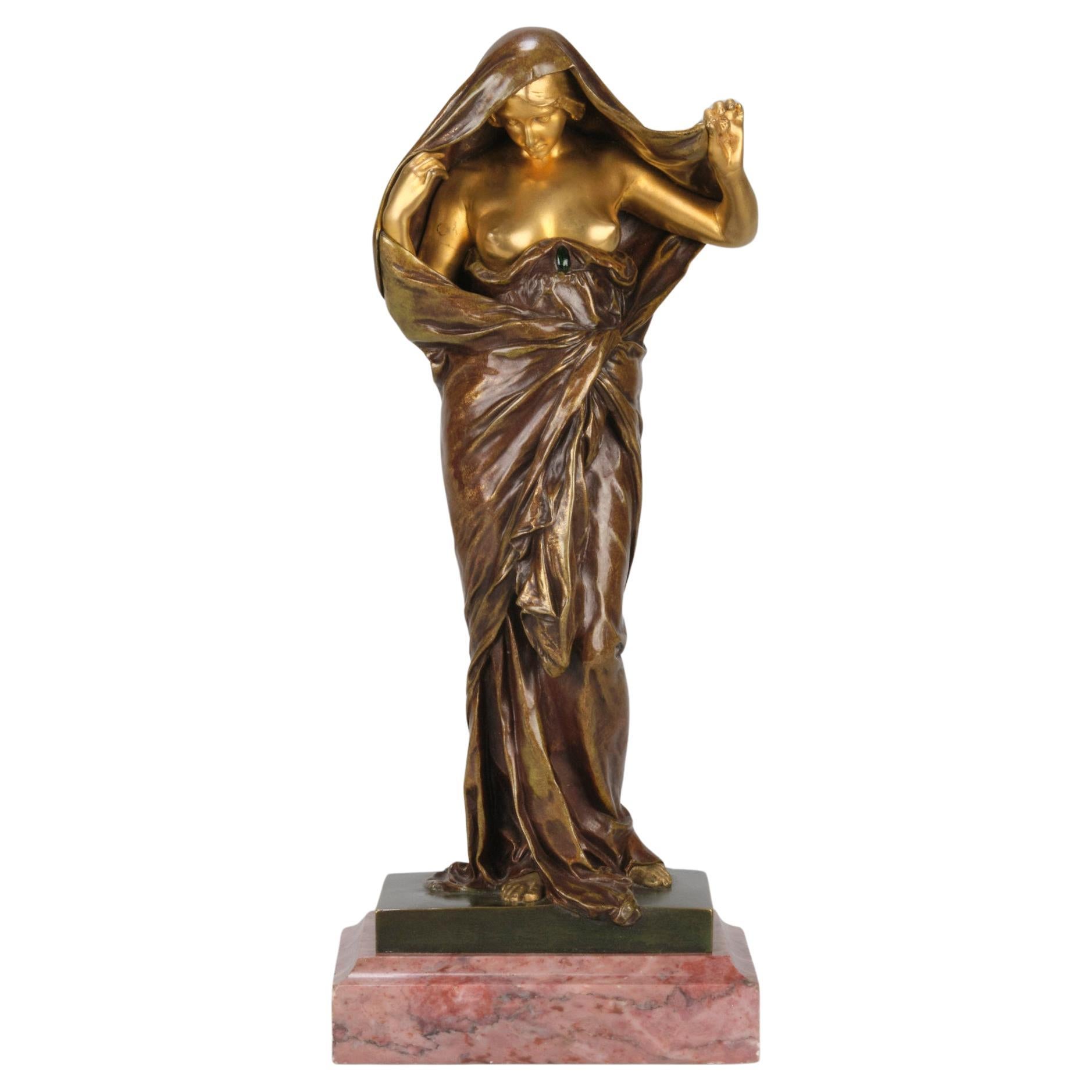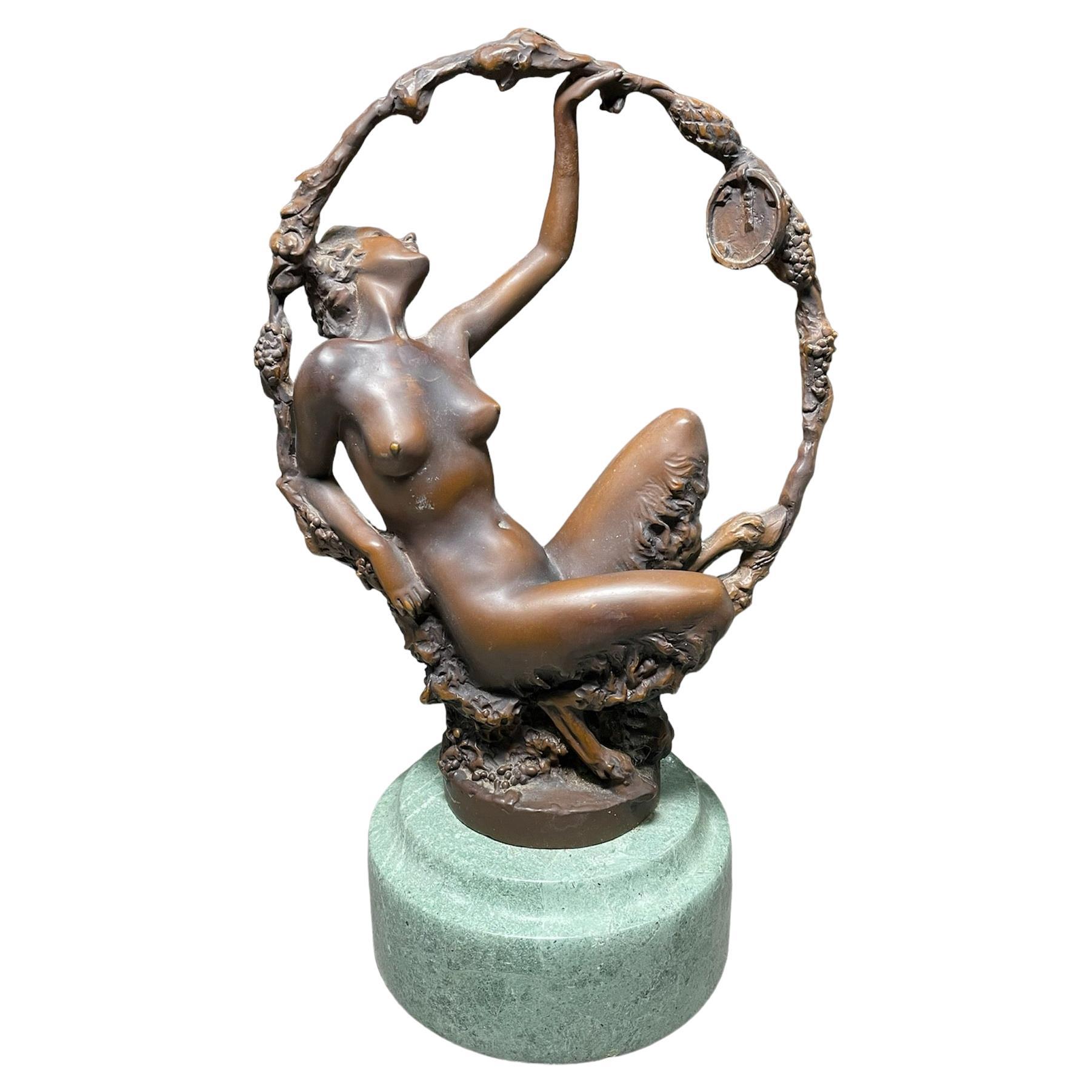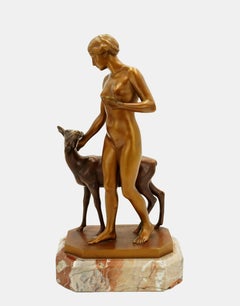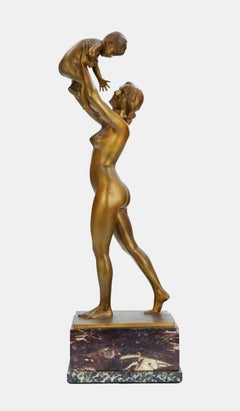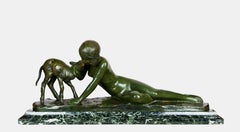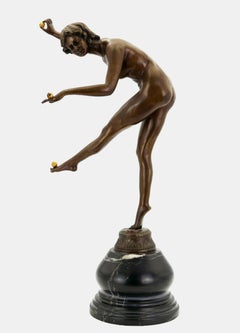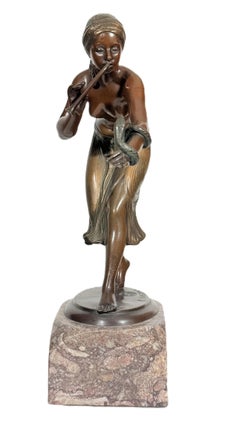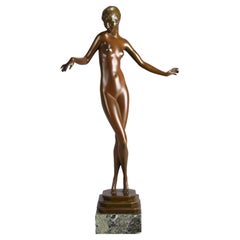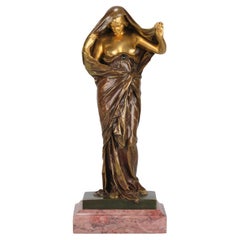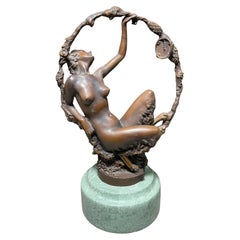Items Similar to The Feeding / - Natural grace -
Want more images or videos?
Request additional images or videos from the seller
1 of 11
Erich Schmidt-KestnerThe Feeding / - Natural grace -c. 1915
c. 1915
$4,317.04
$5,396.3120% Off
£3,211.44
£4,014.3120% Off
€3,600
€4,50020% Off
CA$5,911.51
CA$7,389.3920% Off
A$6,572.79
A$8,215.9920% Off
CHF 3,431.95
CHF 4,289.9420% Off
MX$80,006.91
MX$100,008.6420% Off
NOK 43,790.20
NOK 54,737.7420% Off
SEK 41,029.32
SEK 51,286.6520% Off
DKK 27,404.81
DKK 34,256.0120% Off
Shipping
Retrieving quote...The 1stDibs Promise:
Authenticity Guarantee,
Money-Back Guarantee,
24-Hour Cancellation
About the Item
Erich Schmidt-Kestner (1877 Berlin - 1941 Nordhausen), The Feeding, around 1915. Gold and black patinated bronze with cast brown patinated plinth mounted on a lightly veined black-green marble base (5.5 cm high). Total height 22 cm. Dimensions of the bronze: 16.5 cm (height) x 22 cm (width) x 10 cm (depth), weight 7.2 kg. Signed on the plinth “E[rich]. Schmidt-Kestner.” and with the mark ‘RKB’ in the coat of arms of the Robert Kionsek Berlin foundry.
- The deer's palm and nose partially oxidized, occasionally somewhat rubbed and stained, the base slightly bumped at the rear corners.
- Natural grace -
A graceful deer being fed by a kneeling young woman. She offers something to the deer with one arm and covers her nakedness with the other. This also seems like a gesture of humility before the graceful and shy animal, whose design incorporates Schmidt-Kestner's extensive animal studies. In particular, the head with its antlers and the hind legs give the depiction an intense liveliness.
The young woman has the same gracefulness as the deer and appears equally shy and innocent in her pose. The black forest animal makes her golden appearance all the more radiant, and yet it is she who devotes herself to the animal with caring affection, which in turn draws attention to the deer. The loving feedig connects the young woman and the deer, and the parallel arrangement of the two makes the bond appear as an inner harmony. Although they are separated by the gap between man and beast, they are kindred spirits, so that the nature of the deer also reveals the nature of the young beauty.
About the artist
Erich Schmidt-Kestner first studied sculpture at the Berlin Art Academy and then at the Düsseldorf Art Academy. While still a student, he was awarded a small gold medal at the Great Berlin Art Exhibition in 1904, and the following year he was honored with a gold medal for his work "Striding Girl" at the International Art Exhibition in Munich. After completing his studies, he was awarded the Rome Prize in 1905, which included a two-year residency in Rome. After returning from Italy, Schmidt-Kestner worked as a freelance artist in his home city Berlin from 1908 to 1926. His artistic work was interrupted by World War I, in which he served as a soldier in France and Russia and as an Italian interpreter in the Alpine Corps. In 1926, Schmidt-Kestner was appointed head of the sculpture class at the Königsberg Art School. There he was also honorary deputy director of the zoo and produced numerous animal studies. In 1935 Schmidt-Kestner accepted a position at the Kunstgewebeschule Kassel, which he later headed as director.
In addition to an extensive oeuvre of architectural sculptures, Schmidt-Kestner created numerous bronze monuments and salon sculptures, which were so popular that porcelain manufacturers such as KPM produced works based on his designs.
GERMAM VERSION
Erich Schmidt-Kestner (1877 Berlin - 1941 Nordhausen), Die Fütterung, um 1915. Goldfarben und schwarz patinierte Bronze mit gegossener braun patinierter Plinthe auf hell geädertem schwarzgrünem Marmorsockel montiert (5,5 cm Höhe). Gesamthöhe 22 cm. Maße der Bronze: 16,5 cm (Höhe) x 22 cm (Breite) x 10 cm (Tiefe), Gewicht 7,2 kg. Auf der Plinthe mit „E[rich]. Schmidt-Kestner.“ signiert und mit der Marke „RKB“ im Wappen der Gießerei Robert Kionsek Berlin versehen.
- Handinnenfläche und Nase des Rehs teilweise oxidiert, mitunter etwas berieben und fleckig, Sockel an den hinteren Ecken leicht bestoßen.
- Natürliche Anmut -
Ein graziles Reh wird von einer knieenden jungen Frau gefüttert. Mit dem einen Arm bietet sie dem Reh etwas dar und bedeckt mit dem anderen ihre Blöße. Dies wirkt zugleich wie eine Demutsgeste vor dem anmutigen und scheuen Tier, in dessen Gestaltung Schmidt-Kestners umfangreichen Tierstudien eingeflossen sind. Insbesondere der Kopf mit dem Geweih und die Hinterläufe verleihen der Darstellung eine intensive Lebendigkeit.
Die junge Frau ist von derselben grazilen Anmut wie das Reh und wirkt in ihrer Haltung ebenso scheu und unschuldig. Dabei bringt das schwarze Waldtier ihre goldene Erscheinung umso mehr zum Aufstrahlen und dennoch ist sie es, die sich voll fürsorglicher Zuneigung dem Tier widmet, was wiederum die Aufmerksamkeit auf das Reh lenkt. Die liebevolle Darreichung verbindet die junge Frau und das Reh miteinander, wobei die parallele Anordnung die Verbundenheit als innerer Gleichklang erscheinen lässt. Obwohl sie der Hiatus von Mensch und Tier trennt, sind sie doch wesensverwandt, so dass sich im Naturell des Rehs auch das Naturell der jungen Schönheit offenbart.
zum Künstler
Erich Schmidt-Kestner studierte zunächst an der Berliner und anschließend an der Düsseldorfer Kunstakademie Bildhauerei. Noch als Student wurde ihm 1904 auf der Großen Berliner Kunstausstellung eine kleine Goldmedaille verliehen und im Folgejahr wurde er auf der Internationalen Kunstausstellung München für sein Werk „Schreitendes Mädchen“ mit einer Goldmedaille geehrt. Nach Abschluss des Studiums erhielt er 1905 den mit einem zweijährigen Romaufenthalt dotierten Rompreis. Nach der Rückkehr aus Italien war Schmidt-Kestner von 1908 bis 1926 als freischaffender Künstler in seiner Heimatstadt Berlin tätig. Unterbrochen wurde sein künstlerisches Wirken durch den Ersten Weltkrieg, an dem er als Soldat in Frankreich und Russland und als Italienisch-Dolmetscher im Alpenkorps teilnahm. 1926 wurde Schmidt-Kestner als Leiter der Bildhauerklasse an die Kunstschule Königsberg berufen. Dort war er zudem ehrenamtlich stellvertretender Direktor des Zoos und fertigte zahlreiche Tierstudien an. 1935 folgte Schmidt-Kestner einem Ruf an die Kunstgewebeschule Kassel, die er später als Direktor leitete.
Neben einem umfassenden Oeuvre an Bauplastik schuf Schmidt-Kestner zahlreiche Denkmäler und Salonplastiken aus Bronze, die sich einer so großen Beliebtheit erfreuten, dass Porzellanmanufakturen, wie die KPM, Werke nach seinen Entwürfen ausformten.
- Creator:Erich Schmidt-Kestner (1877 - 1941, German)
- Creation Year:c. 1915
- Dimensions:Height: 8.67 in (22 cm)Width: 8.67 in (22 cm)Depth: 3.94 in (10 cm)
- Medium:
- Movement & Style:
- Period:
- Condition:
- Gallery Location:Berlin, DE
- Reference Number:1stDibs: LU2438215222102
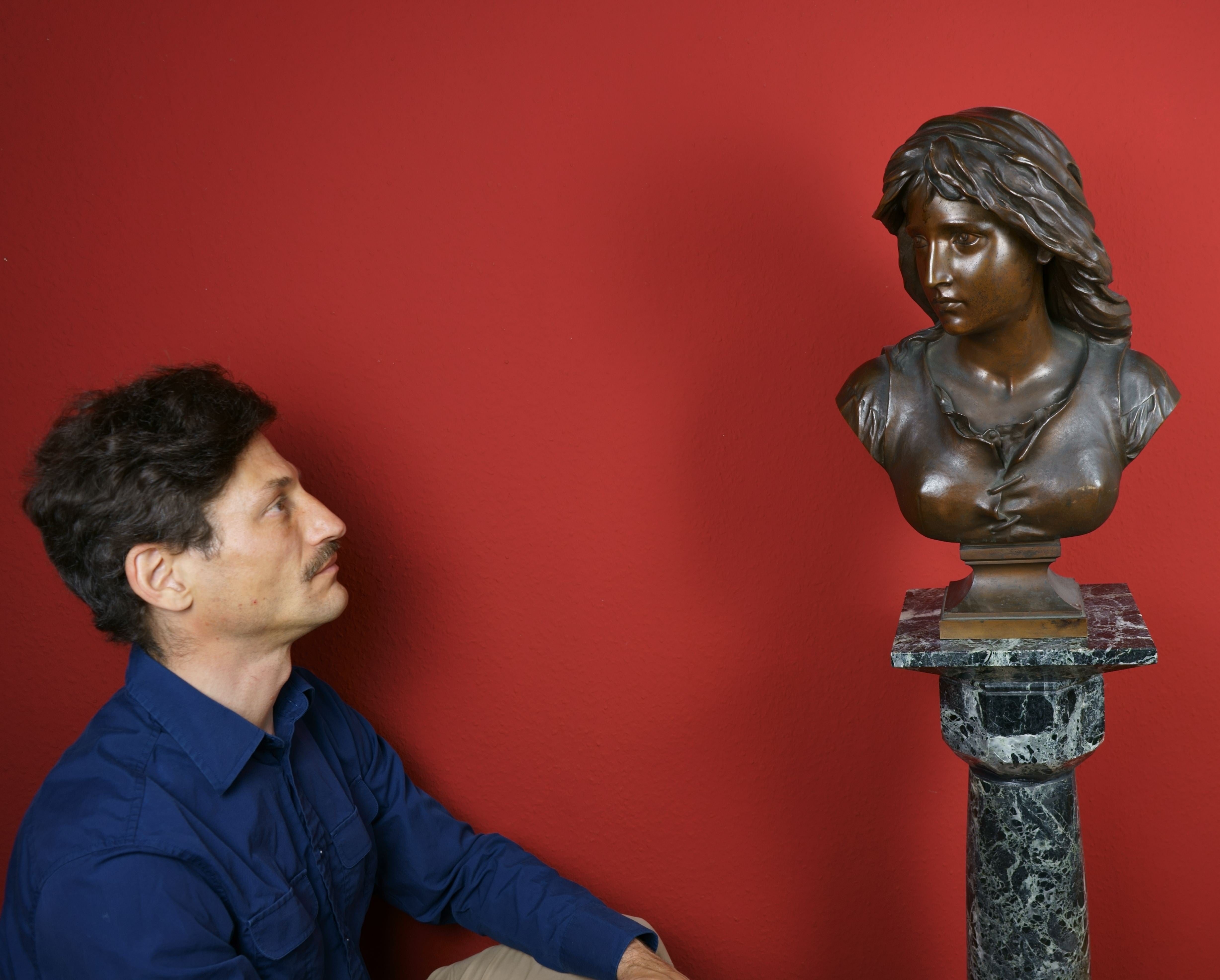
About the Seller
5.0
Gold Seller
Premium sellers maintaining a 4.3+ rating and 24-hour response times
Established in 2014
1stDibs seller since 2023
20 sales on 1stDibs
- ShippingRetrieving quote...Shipping from: Berlin, Germany
- Return Policy
Authenticity Guarantee
In the unlikely event there’s an issue with an item’s authenticity, contact us within 1 year for a full refund. DetailsMoney-Back Guarantee
If your item is not as described, is damaged in transit, or does not arrive, contact us within 7 days for a full refund. Details24-Hour Cancellation
You have a 24-hour grace period in which to reconsider your purchase, with no questions asked.Vetted Professional Sellers
Our world-class sellers must adhere to strict standards for service and quality, maintaining the integrity of our listings.Price-Match Guarantee
If you find that a seller listed the same item for a lower price elsewhere, we’ll match it.Trusted Global Delivery
Our best-in-class carrier network provides specialized shipping options worldwide, including custom delivery.More From This Seller
View AllForest idyll / - Soulmate -
By Rudolf Kaesbach
Located in Berlin, DE
Rudolf Kaesbach (1873 Gladbach - 1955 Berlin), Forest idyll, around 1915. Bronze, gold and golden brown patina, with cast plinth, mounted on a marble base (5 cm high), total height 36 cm, dimensions of the bronze: 31 cm (height) x 17 cm (length) x 12 cm (width). Weight 4,6 kg, signed on the plinth "R.[udolf] KAESBACH".
- a few rubbed areas, overall in excellent condition for its age
- Soulmate -
The bronze sculpture depicts a young woman in an intimate exchange with a deer that accompanies her. The animal pauses to turn toward her, while the nude beauty slows her pace to look into the deer's eyes and tenderly caress it with her hand. The woman and the deer are in inner harmony. Even though her lips remain motionless, she speaks the language of the animal with which she is deeply connected.
The golden patina, which contrasts with the more naturalistic coloring of the deer, gives the young woman the appearance of a saint, even if she cannot be identified as such. At the same time, she evokes memories of Diana, the goddess of the hunt, or a nymph. But she lacks the ferocity. In her innocent naivety, she is more like a vestal virgin, who is not at home in the solitude of the forest. And yet, the young beauty, moving unclothed in the heart of nature, looks like a priestess with her hair tied up and a carefully carried bowl on her way to a sacred grove.
In order to open up the above-mentioned associations, Kaesbach deliberately designed the female figure in such a way that she cannot be identified as a specific person. He has created an allegory of natural femininity, characteristic of Art Nouveau, in which the deer is far more than a companion animal. It displays the same gracefulness as the young woman, and the inner resemblance between the two makes the deer appear as her other self. In animal terms, it embodies her inner being, which also gives the deer an allegorical character.
About the artist
Rudolf Kaesbach studied sculpture at the Hanau Academy and worked in a bronze foundry in Paris in 1900. In order to work as an independent artist, he opened a workshop in Düsseldorf, where he cast bronzes from models he designed. In 1902 he made his debut at the German National Art Exhibition in Düsseldorf. The following year Kaesbach went to the academy in Brussels. There he was inspired by contemporary Belgian sculpture, especially the work of Constantin Meunier. He moved to Berlin, where he opened a studio in the villa district of Grunewald and devoted himself to life-size marble sculptures and the design of bronzes. From 1911, he regularly presented his works at the major art exhibitions in Berlin, as well as in Düsseldorf and Malmö. Between 1936 and 1939, he also created models for the Rosenthal porcelain factory. From 1939 to 1944, Kaesbach was represented at the major German art exhibitions in Munich.
GERMAN VERSION
Rudolf Kaesbach (1873 Gladbach - 1955 Berlin), Waldidyll, um 1915. Gold und goldbraun patinierte Bronze mit gegossener Plinthe, auf einem Marmorsockel montiert (5 cm Höhe), Gesamthöhe 36 cm, Maße der Bronze: 31 cm (Höhe) x 17 cm (Länge) x 12 cm (Breite). Gewicht 4,6 kg, auf der Plinthe mit „R.[udolf] KAESBACH“ signiert.
- vereinzele beriebene Stellen, insgesamt in einem altersgemäß ausgezeichneten Zustand
- Seelenverwandtschaft -
Die Bronzeplastik veranschaulicht eine junge Frau im innigen Austausch mit einem sie begleitenden Reh. Das Tier hält inne, um sich zu ihr hochzuwenden, während die nackte Schönheit ihren Schritt verlangsamt, um dem Reh ebenfalls in die Augen zu schauen und es zärtlich mit der Hand zu liebkosen. Die Frau und das Reh sind in einem inneren Gleichklang. Auch wenn ihre Lippen unbewegt bleiben, spricht sie die Sprache des Tieres, mit dem sie auf eine tief empfundene Weise verbunden ist.
Die im Kontrast zur naturalistischeren Einfärbung des Rehs aufstrahlende goldfarbene Patina lässt die junge Frau wie eine Heilige erscheinen, auch wenn sich nicht als Heilige identifizierbar ist. Zugleich ruft sie Erinnerungen an die Jagdgöttin Diana oder eine Nymphe hervor. Dafür fehlt ihr allerdings die Wildheit. In ihrer unschuldigen Naivität gemahnt sie vielmehr an eine Vestalin, die freilich nicht in der Waldeinsamkeit zu Hause ist. Und doch wirkt die sich unbekleidet im Herzen der Natur bewegende junge Schönheit wie eine Priesterin, die sich mit hochgebundenem Haar und der vorsichtig getragenen Schale und dem Wege zu einem Heiligen Hain befindet.
Um die gennannten Assoziationen zu eröffnen, hat Kaesbach die Frauenfigur bewusst so gestaltet, dass sie nicht als konkrete Person identifizierbar ist. Damit hat er eine für den Jugendstil charakteristische Allegorie natürlicher Weiblichkeit geschaffen, bei der das Reh weit mehr als ein Begleittier ist. Es weist dieselbe grazile Anmut wie die junge Frau auf und der innere Gleichklag der beiden lässt das Reh als ihr anderen Ich erscheinen. Es verkörpert – ins Animalische übertragen - ihr inneres Wesen, wodurch auch dem Reh ein allegorischer Charakter zukommt.
zum Künstler
Rudolf Kaesbach studierte an der Akademie Hanau Bildhauerei und war im Jahr 1900 in einer Pariser Bronzegießerei tätig. Um sich als eigenständiger Künstler betätigen zu können, eröffnete er in Düsseldorf eine Werkstatt, in der er Bronzen nach selbstentworfenen Modellen goss. 1902 debütierte er auf der Deutschen Nationalen Kunstaustellung in Düsseldorf. Im Folgejahr ging Kaesbach an die Akademie nach Brüssel. Dort wurde er von der zeitgenössischen belgischen Bildhauerei, insbesondere vom Werk Constantin Meuniers, inspiriert. Zurückgekehrt zog er nach Berlin, wo er im Villenviertel Grunewald ein Atelier eröffnete und sich neben dem Entwurf für Bronzen der lebensgroßen Marmorbildhauerei widmete. Ab 1911 präsentierte er seine Werke regelmäßig auf den Großen Berliner Kunstausstellungen, aber auch in Düsseldorf und Malmö. Zwischen 1936 und 1939 fertigte er zudem Modelle für die Porzellan-Manufaktur Rosenthal an. Von 1939 bis 1944 war...
Category
1910s Jugendstil Nude Sculptures
Materials
Bronze
$4,029 Sale Price
20% Off
Mother Happiness / - The ecstasy of maternal joy -
Located in Berlin, DE
Johannes Boese (1856 Ostrog - 1917 Berlin), Mutterglück, um 1910. Goldbraun patinierte Bronze auf gegossener rechteckiger Plinthe, montiert auf zweifarbigem Marmorsockel (9,5 cm Höhe...
Category
1910s Art Nouveau Nude Sculptures
Materials
Bronze
$4,029 Sale Price
20% Off
Girl with a Kid / - Caresses of innocence -
By Ary Bitter
Located in Berlin, DE
Ary Bitter (1883 Marseille - 1973 Paris), Girl with Kid, around 1930. Green patinated bronze with cast plinth loosely mounted on a white-veined dark green marble base. Dimensions of the plinth: 5 cm (height) x 80 cm (length) x 24 (width), dimensions of the bronze 28 cm (height) x 72 cm (length) x 18 cm (width). Weight of the bronze 18.2 kg, total weight 39.2 kg. Signed “Ary Bitter.” on the plinth and stamped “L N Paris J L” by the foundry Les Neveux de Jacques Lehmann...
Category
1930s Art Deco Nude Sculptures
Materials
Bronze
$8,634 Sale Price
20% Off
Juggler / - Artistic naturalness -
Located in Berlin, DE
Claire Jeanne Robertine Colinet (1880 Brussels - 1950 Asnières-sur-Seine), Juggler, around 1920. Brownish patinated bronze with gilded balls on a round, multi-profiled stone base (10...
Category
1920s Art Deco Nude Sculptures
Materials
Bronze
Psyche / - Fulfilled longing -
Located in Berlin, DE
Jan Jozef Jaquet (1822 Antwerp - 1898 Brussels), Psyche, 1847. Black-brown and brown patinated bronze on a cast base. 30 cm (height) x 22 cm (width) x 12 cm (depth), weight 5 kg. Ver...
Category
1840s Realist Figurative Sculptures
Materials
Bronze
$1,439 Sale Price
20% Off
Allegory of Progress / - The Driving Force of Inspiration -
Located in Berlin, DE
Ernest Rancoulet (1842-1918), Allegory of Progress, around 1890. Bronze-plated metal cast with cast terrain plinth mounted on a wooden base (6 cm high). 64.5 cm (total height) x 28 c...
Category
1890s Realist Figurative Sculptures
Materials
Metal
You May Also Like
Rudolf KAESBACH (1873-1955) Bronze Jugendstil
By Rudolf Kaesbach
Located in Berlin, DE
Rudolf KAESBACH (1873-1955), "Snake Charmer"
Inscribed 'R. Kaesbach' on the plinth and with the foundry mark, height with base: approx. 30.2 cm
Founding mark RM
Rosenthal & Maeder ...
Category
Early 20th Century Figurative Sculptures
Materials
Bronze
"Delicate" by Paul Philippe
By Paul Philippe
Located in London, GB
An excellent French early 20th Century Art Deco bronze figure of a young attractive naked woman in an elegant pose with rich brown patination, raised on fitted green marble base & si...
Category
Early 20th Century French Art Nouveau Figurative Sculptures
Materials
Marble, Bronze
Late 19th Century Art Nouveau Sculpture "Nature Unveiling" by Ernst Barrias
Located in London, GB
Wonderful late 19th Century Art Nouveau French bronze figure of a seductively draped female figure representing, in allegorical form, Nature revealing her secrets to Science, a fitti...
Category
Antique Late 19th Century French Art Nouveau Figurative Sculptures
Materials
Marble, Bronze
Art Nouveau Faun Woman Bronze Sculpture
Located in Guaynabo, PR
This is a Faun Woman Bronze Sculpture. It depicts a faun nude woman with goat legs who is lying back over a wreath made of vine branches and wit...
Category
20th Century French Art Nouveau Figurative Sculptures
Materials
Marble, Bronze
Louis Ernest Barrias Nature Revealing Herself
By Louis Ernest Barrias
Located in Dallas, TX
Louis Ernest Barrias (French 1841-1905)
Nature Revealing Herself
La Nature se dévoilant devant la Science
Gilt, and silver patinated bronze with blue glass scarab
Signed on base “E...
Category
Early 1900s Art Nouveau Figurative Sculptures
Materials
Bronze
Leda and the Swan Bronze sculpture by Ferd Otratovsky
Located in Buenos Aires, Olivos
Leda and the Swan Bronze sculpture by Ferd Otratovsky.
Signed and dated "FERD. OTRADOVSKY 1926" within the cast on the base.
Black patinated bronze, mounte...
Category
Early 20th Century French Art Nouveau Figurative Sculptures
Materials
Marble, Bronze
More Ways To Browse
Art Plinth
Marble Sculpture Nude
Antique Bronze Nude
Art Nouveau Marble Sculptures
Bronze Nude Woman
Black Bronze Nudes
Art Nouveau Girl
Kneeling Nude
Antique Deer Mounts
Art Nouveau Bronze Nude
Marble Woman Head
Nude Porcelain Sculptures
Bronze French Soldier
Deer Legs
Antique Bronze Deer
Marble Nude Sculpture Woman
Naked Porcelains
Animal Fur Coat
